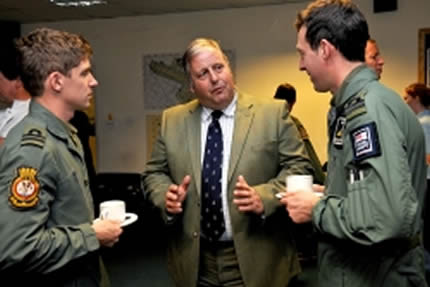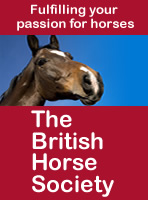
Horseytalk.net/Hoofbeat EXCLUSIVE
RIDER RIGHTS
Says Adrienne Yentis
 A friend of mine recently was riding on the heath
A friend of mine recently was riding on the heath
and she came across a group of cattle strung out across the bridlepath with no way through – the only way off was to turn round. Fortunately her horse
remained calm throughout. But you can imagine how a nervous horse might react ........... read more
Military Helicopter Crews Meet Horse-Riders
In Bid To Understand Each Other
 With An Average Of More Than 4 Horses Per Square Kilometre Over The Whole Of The UK, Low-Flying Helicopters Will, From Time-To-Time, Encounter Riders On Horses. It Is Important That Both Aircrew And Riders Understand The Needs Of The Other.
With An Average Of More Than 4 Horses Per Square Kilometre Over The Whole Of The UK, Low-Flying Helicopters Will, From Time-To-Time, Encounter Riders On Horses. It Is Important That Both Aircrew And Riders Understand The Needs Of The Other.
Welcoming leading representatives of the horse-riding community and members of the media, senior aviators from Royal Naval Air Station (RNAS) Yeovilton offered an open and informal forum for an exchange of information about military flying and the interaction with horse-riders.
Commodore Jock Alexander, the Commanding Officer of RNAS Yeovilton, welcomed the guests and outlined the operations that take place at the Air Station and the units that fly helicopters in the local areas. He said, “Our aircrew are doing today’s business often in extremely demanding environments. Low flying is essential in reducing the risk to helicopters and this is the case whether the operational theatre involves war-fighting operations, peace-support or peace-keeping duties, or even humanitarian relief. We have to train the way we plan to operate and that entails low flying training in the Somerset and the adjacent counties.”
Commander Neil Thompson, who is in charge of flying operations at RNAS Yeovilton, talked about the challenges of low-flying, the limitations imposed on low-flying in helicopters in the UK and the aircrew’s awareness of the impact of low flying. “Our task is to train our aircrew as to be as professional and effective as possible but we also have a responsibility to the local communities and we won’t fly lower than is necessary for the task and, wherever possible, we vary our flight paths to distribute the disturbance.” He said, “If the aircrew see horses with riders, they will do all they can to avoid them but, in some cases, last-minute manoeuvring near the horse can be more disturbing than a gentle climb to increase height.”
The event was held in the main flying briefing room of 848 Naval Air Squadron that trains all Sea King aviators and engineers of the Commando Helicopter Force. The Squadron Commanding Officer, Commander Richard Sutton, explained how aircrew are trained and gave some insights into the challenges of operational low flying. “Flying training and particularly low flying is a highly technical challenge, it requires regular practice and is tightly controlled,” he said, “We are flying our guests to show them how difficult it can be to see horses and their riders; particularly if they don’t help us by wearing high-visibility garments.”
Yeovilton’s programme of engagement with the horse-riding community is founded on a highly productive collaboration with the British Horse Society that has provided unstinting advice and support. The Society was strongly represented with Sheila Hardy, the Senior Executive of the Saf
Safety department and David Prince, the Senior Executive for Communications attending. Bridgwater College’s Cannington Equestrian Centre and Bicton College Equine Centre were represented by Michael (Pepsi) Kohler and Alex Robinson-Barr respectively.
Pepsi Kohler said, “The day was absolutely fantastic and very informative. I now appreciate the role that our helicopters play and understand their training needs. If there is one message I will reinforce, it is the need for horse riders and their horses to be more easily seen by wearing high-visibility attire. Alex Robinson-Barr echoed Pepsi’s themes and added, “I felt privileged to be given such an amazing insight into what the aircrew do and experiencing the flight. You just don’t appreciate how busy they are and we - the riders - usually focus on our concerns and our pursuit of safety without realising what a challenge it is for the helicopters to operate effectively and safely.”
The Community Relations Officer, Jeremy Greenop, who is the Air Station’s focal point for engagement with horse-riders said, “Ideally we would have invited many more people to the event but a key part of the day was the flight in a Sea King helicopter and we were limited to 20 guests on this occasion. I hope the journalists who attended will help spread the word. We take our responsibilities very seriously but we all have to be realistic: low-flying is a crucial facet of our operational proficiency and, with an average of more than 4 horses per square kilometre over the whole of the UK, low-flying helicopters will, from time-to-time, encounter riders on horses. It is important that both aircrew and riders understand the needs of the other.”
Julie Garbutt, the British Horse Society’s South West Regional Development Officer has worked closely with the Air Station on the programme for engagement and the development of their respective Websites. Julie said, “We and all military aircrew have a shared interest, and that is the safety of riders and aircrew. My work with the Naval Air Station at Yeovilton epitomises the respect we have for each other. They have a very important job to do and it is a testament to their commitment to the local communities that they elect to engage as extensively as they do. This has been a most successful event and we were delighted to be able to assist.”
 Says Linda Wright
Says Linda Wright
We moved to a Shropshire location a year ago having surveyed the local OS map and noted the significant number of bridleways around the property. Sadly the map appears a total fiction. Scarce any of the bridleways are usable ........... read more



